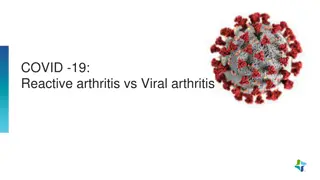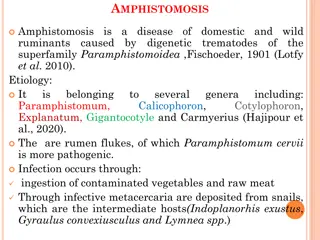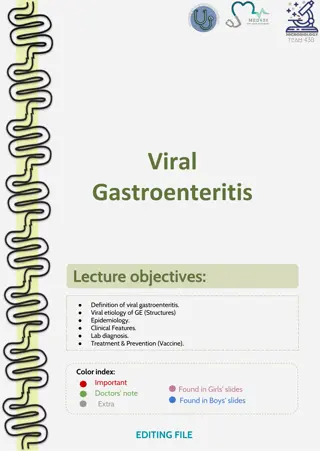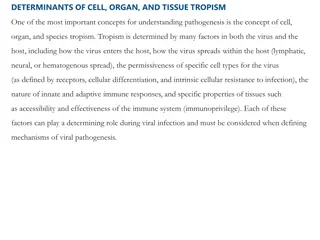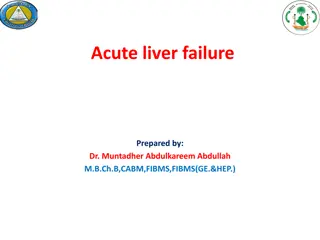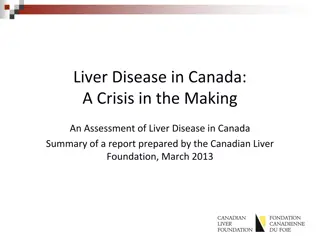Understanding Viral Hepatitis: Causes, Types, and Clinical Symptoms
Viral hepatitis is caused by various hepatotropic viruses, including Hepatitis A, B, C, D, and E. This type of liver inflammation can manifest acutely or chronically, leading to symptoms such as jaundice, abdominal pain, nausea, and fatigue. Hepatitis A virus, in particular, is primarily transmitted through the fecal-oral route and can lead to liver infection after a 2 to 6-week incubation period. Understanding the pathogenesis, clinical symptoms, and resistance of Hepatitis A virus is crucial for effective management and prevention strategies.
Download Presentation

Please find below an Image/Link to download the presentation.
The content on the website is provided AS IS for your information and personal use only. It may not be sold, licensed, or shared on other websites without obtaining consent from the author. Download presentation by click this link. If you encounter any issues during the download, it is possible that the publisher has removed the file from their server.
E N D
Presentation Transcript
VIRAL HEPATITIS Asst. Prof. Dr. Dalya Basil Hanna
VIRAL HEPATITIS Viral caused by five unrelated hepatotropic viruses Hepatitis A, Hepatitis Hepatitis D, and Hepatitis E. Other viruses can inflammation include Cytomegalovirus, Epstein Barr virus. It may present in acute (recent infection, relatively rapid onset) or chronic forms. Hepatitis: is a liver inflammation B, Hepatitis C, also Herpes cause liver simplex,
HEPATITIS VIRUSES Hepatitis A (HAV) Picornaviridae (1973) Hepatitis B (HBV) Hepadnaviridae (1970) Hepatitis C (HCV) Flaviviridae (1988) Hepatitis D (HDV) (1977) Hepatitis E (HEV) (Caliciviridae) (1983), Hepeviridae Hepatitis F Not separate entity Mutant of B Virus. Hepatitis G (HGV) Flaviviridae (1995) 3
HEPATITIS A VIRUS Small, enveloped virus) particle, diameter. Related to enteroviruses, formerly enterovirus 72, now put in its own family. One stable serotype only. HAV is not cytolytic and is released by exocytosis. ssRNA, (Naked icosahedral 27 nm non- RNA in known as
PATHOGENESIS OF HEPATITIS A VIRUS HAV invade into human body by fecal-oral route, multiplies in the intestinal epithelium and reaches the liver by hematogenous spread. After one week, the HAV reach liver cells when replication will occur. Then enter intestine with bile and appear in feces. Incubation Period : 2 to 6 weeks.
CLINICAL SYMPTOMS OF HEPATITIS A VIRUS Jaundice (yellow eyes and skin, dark urine) Abdominal pain Loss of appetite Nausea Fever Diarrhea Fatigue Children often have the disease with few symptoms.
HEPATITIS A VIRUS RESISTANCE Stable to: acid at pH 3 Solvents (ether, chloroform) detergents saltwater, groundwater(months) drying(stable) Temperature - 4 : stable for weeks - 56 for 30minutes: stable - 61 for 20minutes: partial inactivation
LAB.DIAGNOSIS 1. Demonstration of Virus in feces: By: Immunoelectron microscopy 2. Virus Isolation: by tissue culture. 3. Detection of Antibody :By ELISA 4. Biochemical tests: 5. Molecular Diagnosis : Real-Time PCR of feces i) Alanine aminotransferase (ALT) ii) Bilirubin 10
HEPATITIS A VIRUS VACCINE Hepatitis A vaccine in infants is safe and immunogenic without maternal antibody. Combined hepatitis A and hepatitis B vaccine approved by FDA in United states for persons above 18 years old. The schedule of this vaccine is: 0,1,6 months.
HEPATITIS B VIRUS (HBV) Double stranded DNA enveloped virus. Complete particle 42 nm, the core of the virus containing HBcAg and HBeAg, and the coat contain HBsAg and at least 4 phenotypes of HBsAg are recognized. The HBcAg is of a single serotype. Hepatitis B virus (HBV) has been classified into 8 genotypes (A-H).
FOUR STAGES IN THE VIRAL LIFE CYCLE (HBV) The first stage is immune tolerance. The duration of this stage for healthy adults is approximately 2-4 weeks and represents the incubation period. In the second stage, an inflammatory reaction with a cytopathic effect occurs. HBeAg can be identified in the sera. The duration of this stage for patients with acute infection is approximately (symptomatic period). 3-4 weeks
FOUR STAGES IN THE VIRAL LIFE CYCLE (HBV) In the third stage, the host can target the infected hepatocytes and the HBV Viral replication no longer occurs. HBeAb can be detected. In the fourth stage, the virus cannot be detected and antibodies to various viral antigens have been produced.
CLINICAL SYMPTOMS OF HEPATITIS B VIRUS Signs and symptoms of hepatitis B, ranging from mild to severe, usually appear about one to four months after you've been infected. Signs and symptoms of hepatitis B may include: Abdominal pain Dark urine Fever Joint pain Loss of appetite Nausea and vomiting Weakness and fatigue jaundice
LABORATORY DIAGNOSIS Acute HBV infection is characterized by the presence of HBsAg and immunoglobulin M (IgM) antibody to HBcAg detected by EIA (Enzyme Immunoassay). During the initial phase of infection, patients are seropositive for HBeAg, which is a marker of high levels of replication of the virus. The presence of HBeAg indicates that the blood and body fluids of the infected individual are highly contagious.
LABORATORY DIAGNOSIS Chronic infection is characterized by the persistence of HBsAg for at least 6 months (with or without concurrent HBeAg). Persistence of HBeAb is the principal marker of risk for developing chronic liver disease and liver cancer (hepatocellular carcinoma) later in life.
TREATMENT There is no specific treatment for acute hepatitis B. Therefore, care is aimed at maintaining comfort nutritional balance, including replacement of fluids lost from vomiting and diarrhea. Chronic hepatitis B infection can be treated with drugs, including oral antiviral agents, such as tenofovir or entecavir. Treatment can slow the progression of cirrhosis, reduce incidence of liver cancer and improve long term survival. and adequate
HEPATITIS B VACCINE Infants: several options that depend on status of the mother If mother HBsAg negative: birth, 1-2m,6-18m. If mother HBsAg positive: vaccine and Hep B immune globulin within 12 hours of birth, 1-2m, <6m. Adults: 0,1, 6 months. Vaccine recommended in All those aged 0-18, and those at high risk.
HEPATITIS C VIRUS (HCV) Positive stranded RNA genome of around 10,000 bases Enveloped virus, virion, 30-60nm in diameter Morphological structure remains unknown HCV has been classified into a total of six genotypes (type 1 to 6) on the basis of phylogenetic analysis Genotype 1 and 4 has a poorer prognosis and response to interferon therapy.
CLINICAL SYNDROMES OF HCV HCV can cause acute infections but is more likely to establish chronic infections. All the manifestations of chronic hepatitis B infection may be seen, but with a lower frequency i.e. chronic persistent hepatitis, chronic active hepatitis, cirrhosis, and hepatocellular carcinoma.
HEPATITIS D VIRUS The delta agent is a defective virus. The agent consists of a particle 35 nm in diameter consisting of the delta antigen surrounded by an outer coat of HBsAg. The genome of the virus is very small and consists of a single-stranded RNA.
HEPATITIS D - PREVENTION Pre or postexposure prophylaxis to prevent HBV infection reduces the HBV-HDV Coinfection . Education to reduce risk behaviors among persons with chronic HBV infection.
HEPATITIS D - CLINICAL FEATURES Co-infection Severe acute disease. Low risk of chronic infection.
HEPATITIS E VIRUS Calicivirus-like viruses unenveloped RNA virus, 32-34 nm in diameter +ve stranded RNA genome, 7.6 kb in size. very labile and sensitive
PREVENTION OF HEV Avoid drinking water and beverages of unknown purity, uncooked shellfish, and unwashed fruit/vegetables. IG prepared from donors in Western countries does not prevent infection. Unknown efficacy of IG prepared from donors in endemic areas.
THANK YOU THANK YOU




